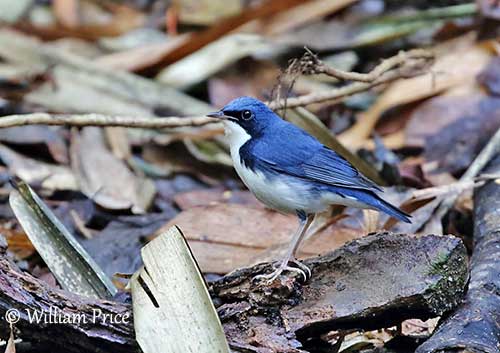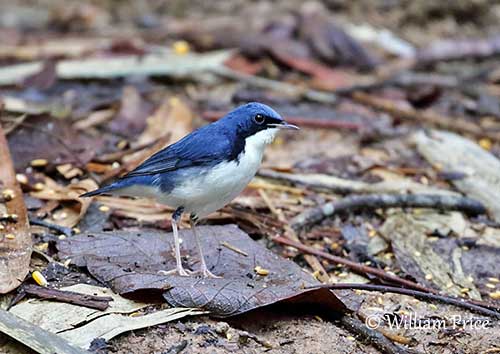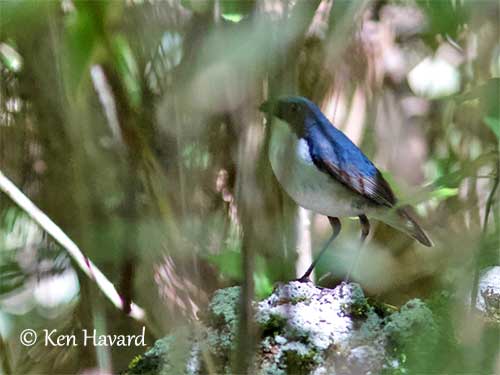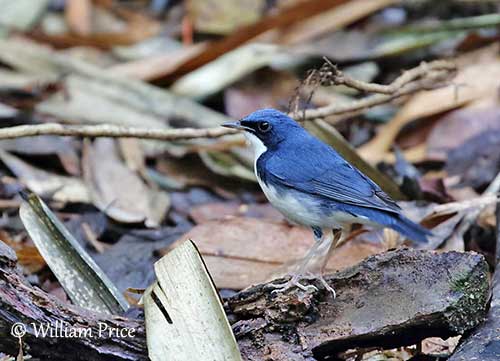
Fr: Rossignol bleu
Ang: Siberian Blue Robin
All: Blaunachtigall
Esp: Ruiseñor Azul
Ita: Usignolo azzurro siberiano
Nd: Blauwe Nachtegaal
Sd: blånäktergal
Photographers:
Ken Havard
My Bird Gallery & Flickr gallery 1 & Flickr gallery 2
William Price
PBase-tereksandpiper & Flickr William Price
Text by Nicole Bouglouan
Sources:
HANDBOOK OF THE BIRDS OF THE WORLD Vol 10 by Josep del Hoyo-Andrew Elliott-David Christie - Lynx Edicions - ISBN: 8487334725
Robins and Chats Par Peter Clement – Editeur: Bloomsbury Publishing, 2016 – ISBN: 1408155966, 9781408155967 - 688 pages
A Field Guide to the Birds of South-East Asia by Craig Robson. New Holland Publishers. ISBN: 9781780090498
Field Guide to the Birds of Thailand De Craig Robson – Editeur: Bloomsbury Publishing, 2020 – ISBN : 1472981405, 9781472981400 – 272 pages
South Dakota Birds and Birding – (Terry L. Sohl)
Wikipedia, the free encyclopaedia
Siberian Blue Robin
Larvivora cyane
Passeriformes Order – Muscicapidae Family
INTRODUCTION:
The Siberian Blue Robin was formerly classified as a species of the family Turdidae, but it is now in the family Muscicapidae, that of the Old World flycatchers.
It breeds in the eastern Palearctic, NE China, N and S Korea and Japan, and migrates to spend the winter in S and SE Asia and Indonesia. It frequents deciduous, coniferous and mixed forests with dense undergrowth when breeding, whereas in winter, it also frequents swamp forest and abandoned plantations, and generally various wet areas. It feeds on insects, berries and grass seeds. The cup-shaped nest is built on or near the ground, well hidden among roots or ferns in thick forest.
The Siberian Blue Robin is described as common throughout the range, but the species is affected by habitat destruction and fragmentation, involving some declines. However, it is not considered globally threatened.
DESCRIPTION OF THE BIRD:
Biometrics:
Length: 13-14 cm
Weight: 11-18 g
The Siberian Blue Robin adult male has forehead, crown to ear-coverts and neck sides, upperparts and upperwing deep blue to slaty blue. The flight feathers are darker with deep blue outer webs and all tertials. The tail is blackish with blue-black central pair and outer webs of outer rectrices.
The underparts are white with blue-grey flanks and thighs. On the underwing, coverts and axillaries are dark grey with bluish tips.

On the head, the area from lores to eye and across cheeks to neck sides is black, becoming broader on breast sides. Some variations may occur with finely tipped or mottled blue below the eye, and blue rear cheeks.
The bill is black, although the lower mandible is pinkish in winter. The eyes are dark brown. Legs and feet are pale pinkish.
In worn plumage, the upperparts are deeper glossy blue. In mid-summer during the moult, they often show some grey bases and fringes to wing feathers, with greyer or greyish-blue outer primaries.
The adult female is like the Rufous-tailed Robin, but she is slightly greyer above. Wings, rump and tail are bluish-brown. On the underparts, the scaling pattern is weaker and buffier, and flanks are paler brown.
The juvenile has blackish-brown plumage with ochre-rufous streaks above. Throat, breast and flanks are brownish-ochre with weak scaling. The belly is whitish.
The young male has bluish uppertail, but it is brownish in the young female.
SUBSPECIES AND RANGE:
The Siberian Blue Robin has three subspecies.
L.c. cyane (described above) breeds in extreme NE Kazakhstan (W Altai), SC Siberia and N Mongolia. It winters in S China (W Yunnan) and SE Asia (from C Myanmar to Borneo).
L.c. bochaiensis breeds in E Siberia, NE China (N Inner Mongolia) and Korea. It winters in Cambodia, Vietnam, S Malay Peninsula, Sumatra and Borneo.
This race has darker upperparts than nominate.
L.c. nechaevi breeds in Sakhalin, S Kuril Islands and Japan. It winters beyond SE Asia.
This one is also darker, but it is slightly larger and shows greater extent of black on body sides.

HABITAT:
The Siberian Blue Robin breeds in coniferous forest with dense undergrowth. It mainly favours spruce (Picea), birch (Betula), pine (Pinus) and aspen (Populus). It is found in dense scrub patches among fallen trees and branches, in gallery forest along taiga meadows, riverside bushes and mountain aspen-fir tracts.
It frequents deciduous, mixed and coniferous forests in Japan, with dense undergrowth and often near streams. It occurs at 1,000/1,600 metres of elevation in montane forest in Japan.
It winters in evergreen forest, swamp forest and abandoned plantations, in damp forest areas and along streams and edges of mangroves. It can be found in parks and gardens on migration.
The species occurs from sea-level to 1,500 metres in wintering areas, occasionally higher on Borneo (1,600/1,700 metres) and on passage.
CALLS AND SONGS: SOUNDS BY XENO-CANTO
The usual calls of the Siberian Blue Robin include a subdued, hard “tuk”, “tak” or “dak” and a louder “sae-ic” or “suae-ik”. We can also hear a rapid, low “tek-tek-tek” or “chuck-chuck-chuck”. The alarm call is a short “tack” given singly or with two notes “tak-tak”.
The song is a short, loud trill separated by pauses. This rather explosive song is often introduced by fine, spaced “sit” notes. It is described as “tri-tri-tri-tri, tjuree, tiu-tiu-tiu-tiu...” and given during the breeding season.
More complex songs may contain up to 5-6 different components such as trills and single notes. The male’s repertoire includes 7-14 song types.
BEHAVIOUR IN THE WILD:
The Siberian Blue Robin feeds primarily on insects including bugs, beetles and ants. In China, it consumes berries and grass seeds during summer. Small clams, insect larvae and spiders are also part of its diet.
It forages on the ground among the leaf litter and in the dense, low vegetation, running and hopping around, skulking through the undergrowth while flicking the tail.
The species is usually difficult to observe as it is often in thick cover, and especially if not vocalising.

The Siberian Blue Robin can be seen in pair during the breeding season, but it is usually solitary outside this period. It is territorial and sings loudly to proclaim and maintain this area.
The courtship displays are poorly known, but male and female have strongly dimorphic plumages, and we can suggests that the beautiful blue plumage of the male is enhanced by adapted postures in front of the female.
The nest of this species is a cup-shaped structure placed on or near the ground.
The Siberian Blue Robin is migratory. During the migration, the birds usually avoid the Himalayas and associated ranges. They migrate by night. Some individuals have sufficient fat reserves for a non-stop flight of several hundred kilometres, whereas others with little or no fat reserves perform shorter flights.
The flight is fast and direct with rapid wingbeats.
REPRODUCTION OF THIS SPECIES:
The breeding season occurs in June/July in Russia and May/July in China and Japan. The territory is established in coniferous or deciduous forest in Japan.
The nest is a bowl-shaped depression made of leaves, grasses and mosses, with a lining of animal hair. It is placed on or near the ground, on bank among tree roots, or protected under fallen tree and usually concealed by thick vegetation.
The female lays 4-6 bright blue to greenish-blue eggs, and she incubates alone.
Brood parasitism by Hodgson’s Hawk Cuckoo may occur. No more information.
PROTECTION / THREATS / STATUS:
The Siberian Blue Robin is usually common throughout the range, although the species is affected by habitat destruction and fragmentation. It is rare in N Vietnam, scarce in China and locally numerous in Korea.
The population seems to be declining, but the species is not globally threatened and the Siberian Blue Robin is currently evaluated as Least Concern.
